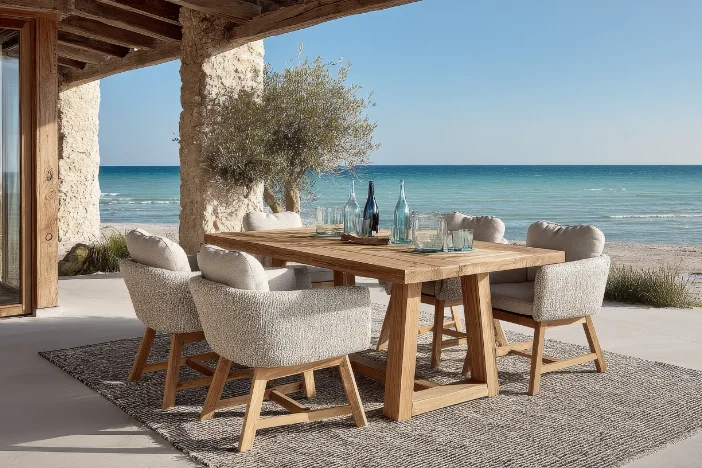
Your patio or deck may already be stunning; the wood’s expertly finished and you want to stare at its natural beauty all day. But if you take a step back, you’ll realize that in reality, it’s looking a bit bare and boring.
One way to perk things up is to get an outdoor rug. Not only can it complement your furniture but it can also create a new focal point. Not to mention, there are many other benefits too.
But you can’t just grab a rug, set it outside and call it a day. Here’s how to buy outdoor rugs that’ll suit your needs and style perfectly.
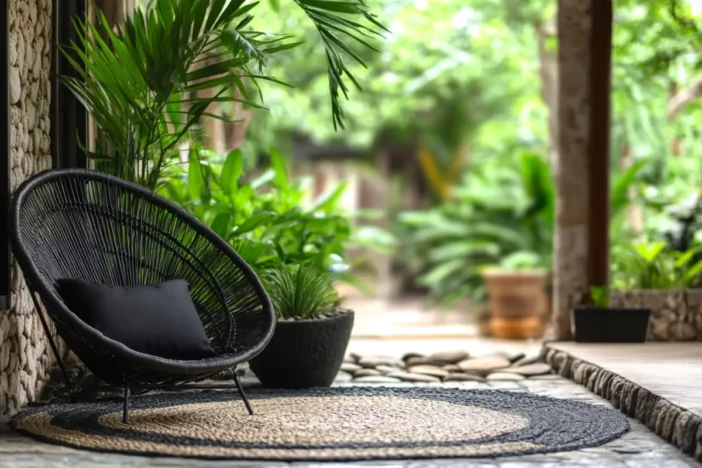
Benefits of Getting Outdoor Rugs
First of all, why should you even get an outdoor rug? They may be pretty to look at and they can add visual warmth by defining spaces and adding color, texture and personality. But indoor outdoor area rugs offer more than just aesthetic appeal.
These are the benefits you can get from them:
- Comfort
- Protection
- Non-slip surface
- Noise reduction
Another upside is that it’ll shield your deck from things like:
- Scratches
- Spills
- UV damage
If you’re worried about loved ones slipping, then a non-slip outdoor rug is hugely advantageous too. Placing one in a high-traffic or poolside area can prevent accidents from happening.
Now that you’re sold on the benefits of outdoor rugs, let’s go over the criteria you should consider before making a purchase.
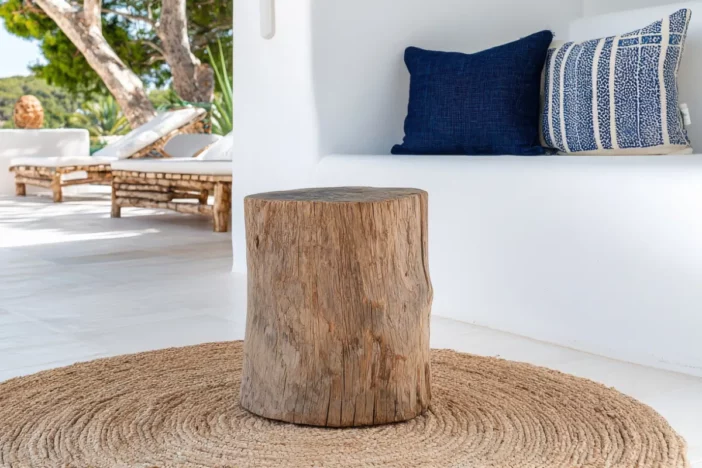
Surface Considerations
It may be surprising but the type of surface you’re putting the rug on will impact your choice. Not only will the rug have an effect on the surface but it also works the other way around.
Here are the common surface types and what you should think about.
Wood Decking
You’ll want breathable rugs with a ventilated backing for wood decking. Rubber-backed ones aren’t ideal since they can trap moisture and cause mold or rot.
Composite Decking
If the rug backing isn’t compatible with your deck, then the materials can stain or discolor your rug. Always check the manufacturer’s recommendation; in general, stay away from latex or rubber backings unless the labels say they’re safe.
Concrete or Pavers
Most outdoor rugs work well here but do note that concrete can be slippery when wet. So you’ll want to opt for a rug with a rough texture or use a non-slip pad.
Unsealed concrete is porous as well, which can encourage mildew growth. To prevent this from happening, get a rug made of breathable material.
Tile
Outdoor tiles are already slick but they’re especially so when wet. This is why it’s essential to look for rugs with non-slip backing. Otherwise, use a grippy rug pad underneath for better safety.
As for the tile itself, ensure that the grout is well-sealed to prevent mold and mildew growth.
Grass or Dirt
If you place your rug directly on grass or dirt, it probably won’t last long; it’ll get wet and grow mold and mildew on the back. Instead, look for turf rugs or camping-style mats that are specifically designed for temporary or uneven surfaces. Or you can put down temporary flooring.
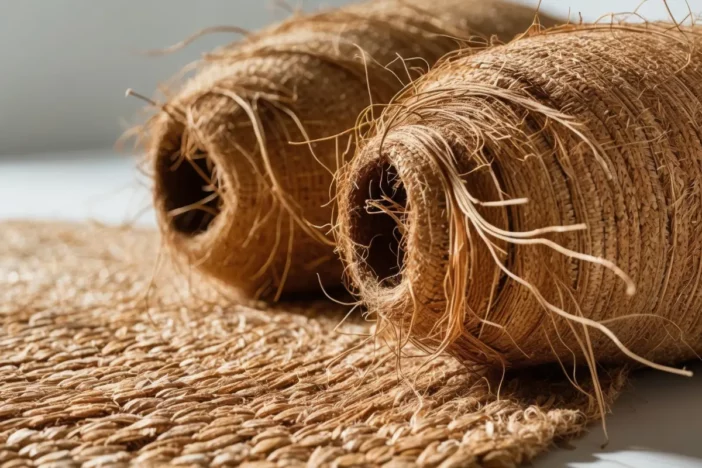
Materials for Outdoor Area Rugs
As you might already know, materials have different durability, comfort and weather resistance. Below are the most popular options available.
Natural Fibers
Natural fibers include:
- Jute
- Sisal
- Seagrass
These are fantastic if you want an earthy, textured appearance and they work well in covered patios or sunrooms. However, they’re not water-resistant, so they’re prone to mold if they’re exposed to moisture.
Polypropylene (Olefin)
Polypropylene is perhaps the best material for most outdoor spaces. Polypropylene rugs have many benefits, such as being:
- Inexpensive
- UV-resistant
- Water-resistant
- Stain-resistant
The caveat is that it’s less eco-friendly, making it a less ideal choice for those who want to reduce their carbon footprint. It may also feel plasticky under your feet.
Polyester
Polyester is another popular choice and you’ll often find it in covered porches and patios. There’s vivid color retention, plus it has a soft texture. The drawbacks are that polyester can hold onto oily stains and it’ll need more frequent cleaning.
You can consider getting a polypropylene and polyester combination, such as with Jaipur Living rugs. Not only is it durable but it’s also easy to clean.
Nylon
Nylon’s what you need if you want rugs for high-traffic areas. It’s strong and fade-resistant, meaning you won’t have to replace your rug often.
However, nylon is less water-resistant and can absorb stains more easily.
Weather Resistance
Depending on where you live, your outdoor rugs may face the following:
- Sun
- Rain
- Wind
- Snow
To combat these elements, look for rugs that have:
- UV resistance
- Water resistance (e.g., synthetic materials)
- Mold and mildew resistance
- Wind durability (heavier rugs or those with backing grip)
If your location gets snow or freezing temperatures, then you should store your rug during the offseason to prolong its life.
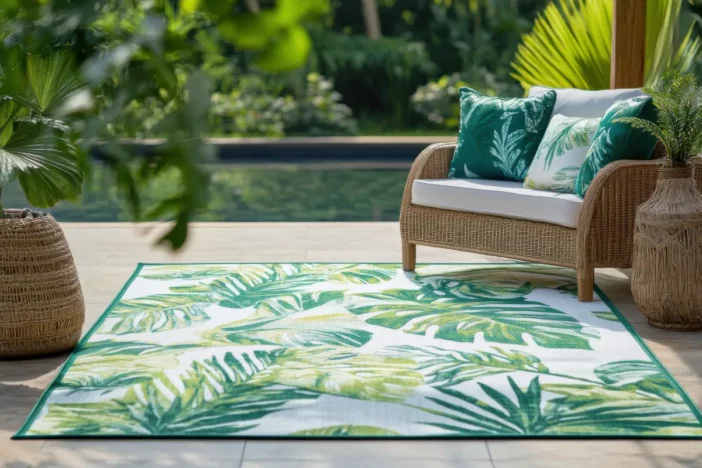
Design and Color
There’s no right or wrong path here, as style is subjective. However, if you need a little help to ensure long-term satisfaction, then here are a few tips.
Pattern Choices
If you’re after a modern outdoor rug, then get a geometric or striped one. The shapes or stripes will provide a clean look.
Those who want to create a relaxing and inviting atmosphere should go with floral or botanical patterns. Both add to a more natural aesthetic.
For an artistic or eclectic vibe, opt for Bohemian or tribal patterns. These add a bit of edginess too.
Colors
Light hues can be great for dark patios, as they add a pop of color to the area. But the main drawback is that they may show dirt easily, so you’ll have to stay on top of cleaning your rug.
On the other hand, dark colors can hide dirt well. However, they fade faster in strong sunlight.
In the middle, you have neutral tones. They’re easy to match and they’re timeless too.
Other Tips
If you can’t make up your mind, then get a reversible rug. You get two looks in one, so you can make a quick seasonal change or update to your outdoor living space. And since you’re utilizing both sides, it’ll extend the rug’s lifespan.
To get a more cohesive look, match your rug with:
- Cushions
- Planters
- Umbrellas
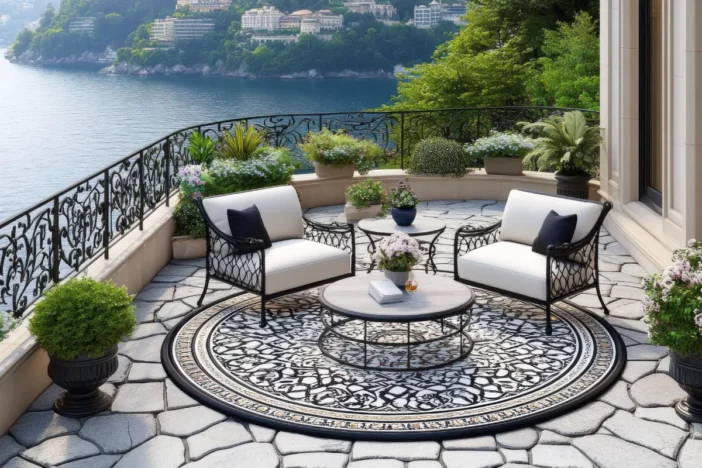
Sizing Guidelines
You’d be surprised but the right size rug really anchors your furniture and enhances the layout. We’ll provide you with this handy cheat sheet for sizing. Keep in mind that you should mark out rug dimensions with painter’s tape before you buy, so you can visualize the fit.
Dining Area
In general, you should allow for 24-30 inches around the table so that the chairs are still on the rug when you pull them out. Typically, if you have a table that seats 6, a 6×9 ft or 8×10 ft rug should suffice. For a huge dining area, you may need an extra-large outdoor rug.
Conversation Area
At a minimum, the front legs of the sofas and chairs should sit on the rug. But ideally, all legs should be on the rug for a fully grounded look. Popular sizes here include:
- 5×8 ft
- 8×10 ft
- 9×12 ft
Small Spaces
You can put down rugs for balconies and entryways to add some interest to your spaces. As you may have guessed, you’ll need something smaller for these tight spots, such as a 2×3 ft or 3×5 ft rug.
For long patios, consider a runner-style rug, such as 2.5×7 ft or longer.
Layering Rugs
Want some depth and personality? Then layer a smaller, decorative rug over a larger neutral one. This is especially useful in boho or modern farmhouse styles.
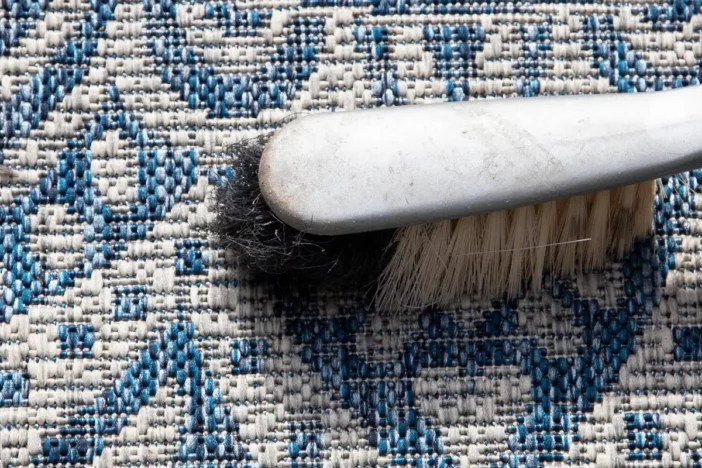
Cleaning and Maintenance
In general, outdoor rugs are low-maintenance. However, if you perform regular care, it’ll extend their lifespan and keep them looking fresh.
Here are our top cleaning and maintenance tips:
- Regular upkeep – Shake out debris weekly and vacuum with a brushless suction attachment
- Spot cleaning – Use a soft brush or cloth and gently scrub with a mix of mild dish soap and water
- Deep cleaning – Hose off the rug and scrub as needed and then hang to dry thoroughly and prevent mildew
- Preventing mold – Dry the rug completely after rain and use breathable rug pads to encourage airflow underneath
- Storage – Roll, don’t fold, and store in a dry, covered area during winter or when not in use

Safety
For everyone’s safety, you should use outdoor-specific non-slip pads to prevent the rug from shifting or curling. And opt for low pile height, as rugs with short fibers reduce trip hazards. Plus, they’re easier to clean.
You should also look for heat-sealed or tightly woven edges. This can prevent fraying, which can be a tripping risk over time.
On windy days, you can keep rugs flat and secure by using corner anchors. Heavy patio furniture pieces can keep them in place too.

Pick the Right Outdoor Rugs
Outdoor rugs can make a world of difference, especially in terms of the aesthetics of your outdoor space. It can add depth and dimension, as well as pops of interesting color. In addition, they can make things more comfortable.
With this rug-buying guide, you’ll be well-equipped to choose the perfect one that’ll complement your current space’s style.





Leave a Reply